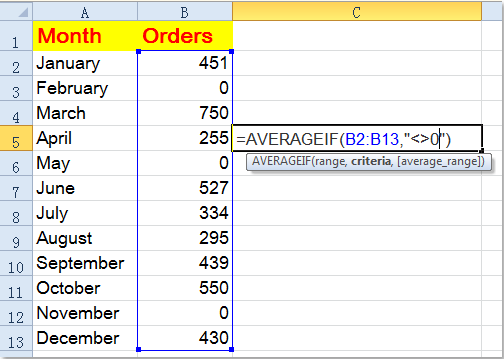How to average a range of data ignoring zero in Excel?
Normally, the Average function can help you to calculate the average of range including zeroes in Excel. But here, you want to exclude the zeroes when you apply the Average function. How could you ignore zeroes in an average calculation?
Average a range of data ignoring zeroes with formula
Average/sum/count a range of data ignoring zeroes with Kutools for Excel
 Average a range of data ignoring zeroes with formula
Average a range of data ignoring zeroes with formula
If you are using Excel 2007/2010/2013, this simple AVERAGEIF function can help you to solve this problem quickly and easily.
1. Enter this formula =AVERAGEIF(B2:B13,"<>0") in a blank cell besides your data, see screenshot:

Note: In the above formula, B2:B13 is the range data that you want to average exclude zeroes, you can change it as your need. If there are blank cells in the range, this formula also average the data exclude the blank cells.
2. Then press Enter key, and you will get the result which has excluded zero values. See screenshot:

 Average/sum/count a range of data ignoring zeroes with Kutools for Excel
Average/sum/count a range of data ignoring zeroes with Kutools for Excel
If you want to sum/average/count ignoring zero cells, you can apply Kutools for Excel's Select Specific Cells utility to select non-zero cells, and then view the calculation result in the Status bar.
After free installing Kutools for Excel, please do as below:
1. Select the range you want to average, click Kutools > Select > Select Specific Cells. See screenshot:
2. In the popping dialog, check Cell option, and then choose Does notequal from first drop down list in Specific type section, and go to right textbox to enter 0. See screenshot:
3. Click Ok, and all cells have been selected exclude zeros, and you can view the average, sum, count result in the Status bar. See screenshot:
Related article:
How to calculate average without max and min values in Excel?
Best Office Productivity Tools
Supercharge Your Excel Skills with Kutools for Excel, and Experience Efficiency Like Never Before. Kutools for Excel Offers Over 300 Advanced Features to Boost Productivity and Save Time. Click Here to Get The Feature You Need The Most...
Office Tab Brings Tabbed interface to Office, and Make Your Work Much Easier
- Enable tabbed editing and reading in Word, Excel, PowerPoint, Publisher, Access, Visio and Project.
- Open and create multiple documents in new tabs of the same window, rather than in new windows.
- Increases your productivity by 50%, and reduces hundreds of mouse clicks for you every day!
All Kutools add-ins. One installer
Kutools for Office suite bundles add-ins for Excel, Word, Outlook & PowerPoint plus Office Tab Pro, which is ideal for teams working across Office apps.
- All-in-one suite — Excel, Word, Outlook & PowerPoint add-ins + Office Tab Pro
- One installer, one license — set up in minutes (MSI-ready)
- Works better together — streamlined productivity across Office apps
- 30-day full-featured trial — no registration, no credit card
- Best value — save vs buying individual add-in